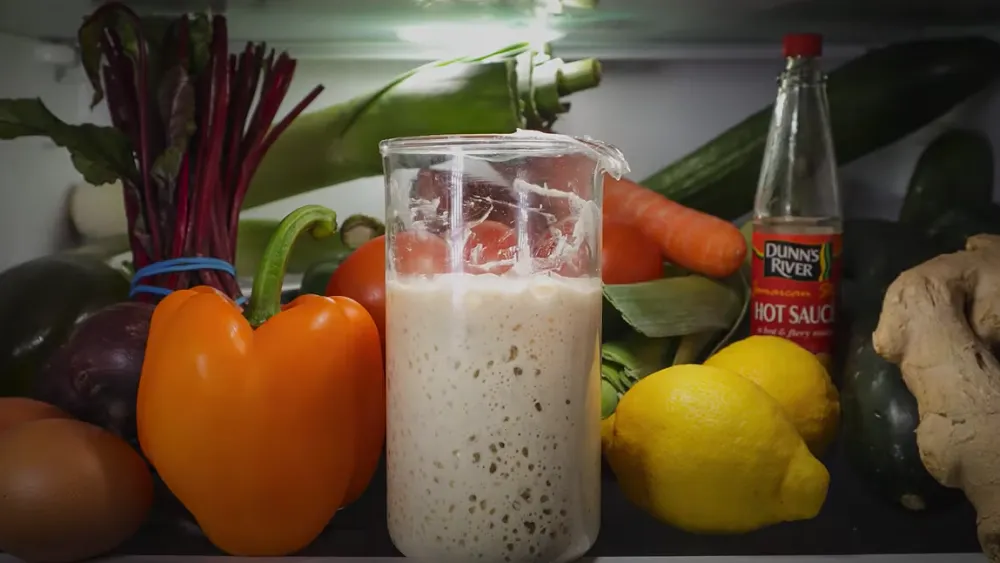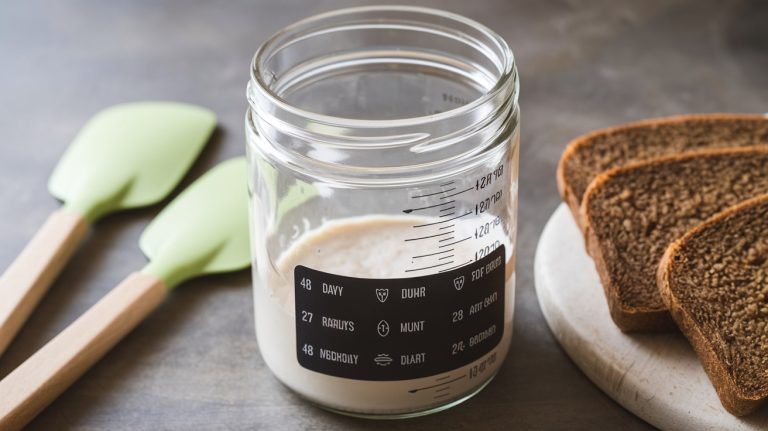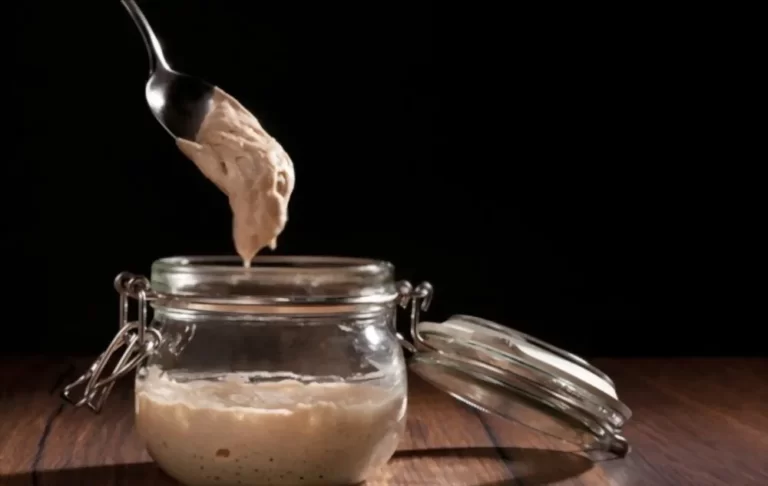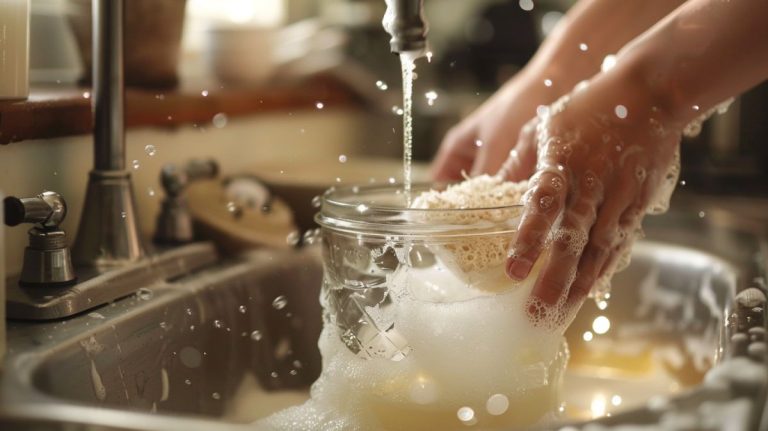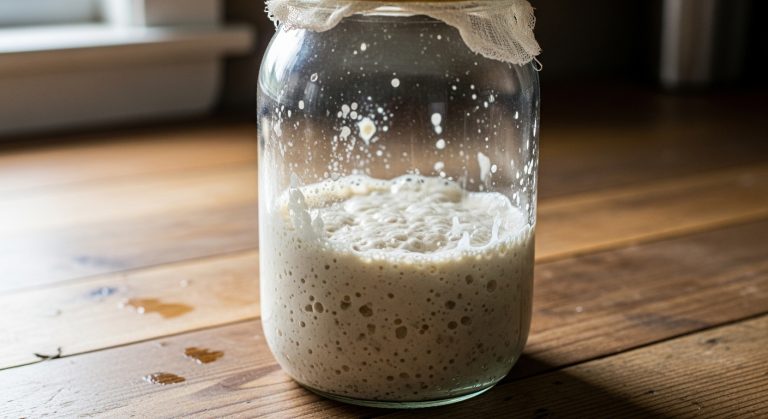How Long Can Sourdough Starter Stay in Fridge to Retain Freshness and Long-Term Usability?
Thinking of making sourdough bread for your family? Undoubtedly, a sourdough starter is one of the stars of homemade bread, creating a rich, artisan-inspired flavor and texture, perfect for adding a cozy vibe and aroma to your dinner.
But trying to keep up with starter maintenance? Now that can be tough.
Storing a sourdough starter in the refrigerator can be an easy and convenient way to maintain its health and viability over extended periods of time. But maintaining a sourdough starter when you’re not baking often can be a drag, which not everyone wants or has time for.
It is important, however, to know how long a starter can stay in the fridge, as improper storage can lead to an expired or unhealthy starter, wasting precious flour and time. For optimal results when preserving sourdough starter in the fridge, use an actively managed starter recently fed twice.
It is recommended to refrigerate the starter between feedings for short-term storage (up to 3-4 days), medium-term storage (up to 2 weeks), and even long-term storage (4+ weeks). Trust your senses when assessing the viability of a starter.
And before refrigerating again, it should be fed once more to ensure a balanced yeast and bacteria mixture, which leads to better-tasting bread.
Let’s discover how to store and freeze sourdough starter, so it is ready for baking. Also, learn how to revive a starter that has been stored away, what factors affect its longevity, and what to do if it goes bad.
What are the Ideal Conditions for Keeping a Sourdough Starter in the Fridge?
When you think of storing sourdough starter in the fridge, it’s important to understand the ideal conditions. The goal is to ensure that your starter is stored in an environment that’s neither too hot nor too cold, with minimal fluctuation in temperature.
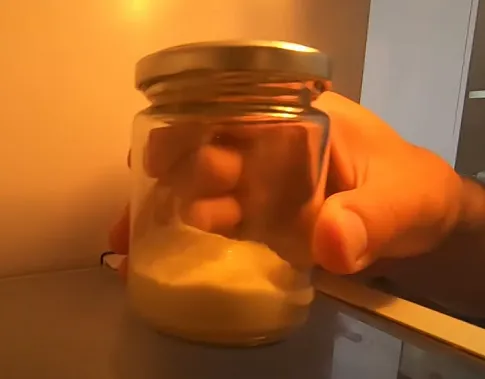
Let’s look at the ideal fridge storage conditions for sourdough starter:
Recommended Temperature Range:
The ideal temperature range for storing sourdough starter in the fridge is between 38-40°F (3-4°C). This is because the cold temperature slows down the activity of the yeast and bacteria in the starter, putting it into a dormant state.

This temperature range is typically the temperature of the main compartment of a refrigerator. It’s important to avoid storing the starter in the fridge door, as the temperature there can fluctuate too much and affect the health of the starter.
Keeping the Starter Covered and Airtight:
Keeping the sourdough starter covered and airtight is crucial for a few reasons. One way to achieve this is by using a jar or container with a tightly fitting lid.

It’s also recommended to store the starter in a slightly damp container. To do so, wrap the container with a damp cloth or paper towel before placing it in the fridge.
By doing this, you’ll be able to maintain the ideal moisture level of the starter and prevents the starter from drying out, which can damage the yeast and bacteria. It prevents the starter from absorbing moisture from the air, which can cause it to become overly wet and difficult to work with.
Airtight storage can also prevent the starter from absorbing any unwanted flavors or odors from other food items in the fridge.
Feeding the Starter Regularly Before and After Storing:
Feeding your sourdough starter regularly is essential to keep it healthy and maintain its optimal flavor. Before storing it in the fridge, it’s important to feed it to ensure that it has enough food to survive.
When ready to use it again, feed it to activate the dormant yeast and bacteria. If you plan to store it for an extended period, feed it a few times over a few days to build up its strength.
Although sourdough starter can survive for months without being fed, feeding it once a week or every two weeks is recommended to keep the yeast and bacteria active. Keeping it in the refrigerator can slow down its metabolic activity if you want to store it longer without feeding it.
If the starter is left unfed for too long, it may shrink and develop a hooch layer, indicating it’s hungry. If neglected for an extended period, the starter may eventually die.
The feeding process helps replenish the nutrients the yeast and bacteria need to thrive. When the starter is healthy and fed, it should be bubbly and active.
Optimal Storage Depending on the Expiration Date:
Sourdough starter is a resilient culture that can last several months without feeding. Proper storage in the refrigerator can help extend its lifespan.
There are different ways to store sourdough starter for long-term use, including in the refrigerator, freezer, or kitchen cabinet after drying it. Every storage method has its expiration date, so if you want to keep your dough alive and kicking for baking sessions down the line, it’s critical to understand which way will best suit your needs.
The duration of storage depends on the storage method used. Choosing the right method is crucial for maintaining the starter’s health and flavor.
- Short-term storage, such as storing the starter for up to 3-4 days between feedings, is ideal for maintaining your starter’s optimal health and flavor. This method is great if you plan to use your starter frequently, as it will be in its prime condition for baking.
- Medium-term storage, storing the starter for up to 2 weeks between feedings, is ideal if you don’t plan to bake regularly. This method allows you to keep your starter in the fridge longer without worrying too much about its health and flavor.
- Long-term storage, or storing the starter for up to 4 weeks or more between feedings, is possible but requires more attention to keep the starter alive and healthy. If you take an extended baking break, this method is best.
You’ll need to feed your starter a few times over a couple of days before storing it to build up its strength. And you’ll need to check on it periodically to ensure it’s still alive and healthy.
If you notice any signs of mold or off odors, you may need to discard them and start over.
Factors that Affect the Lifespan of Sourdough Starter in the Fridge
The lifespan of a sourdough starter in the fridge depends on several factors, such as the strength of the starter culture, the environment in which it’s stored, and how frequently it’s fed.
The stronger the starter culture, the longer it will last without feeding.
Refrigerator Temperature:
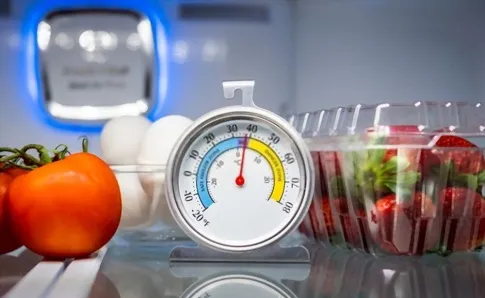
The temperature of the fridge or freezer is a critical factor in determining how long a sourdough starter can last. Ideal storage temperatures should range between 38-40°F, as this helps keep the starter alive and healthy.
Anything above or below this range could damage the starter’s longevity, so monitor your refrigerator’s temperature regularly. The environment should be cool and dry to keep mold from growing on the surface of your starter.
Humidity and Moisture Level:
Achieving the correct moisture level for your sourdough starter is essential to remain viable in the refrigerator. If it’s too dry, then the starter will not be able to survive; likewise, if it’s too wet, then mold or bacteria may set in and damage the starter.
Therefore, monitoring and maintaining optimal moisture levels is key to prolonging your starter’s lifespan.
Acidity Level:
The acidity level of your sourdough starter can influence its flavor and texture greatly over time. If you plan on storing your starting for an extended period, ensure you have a reliable way of measuring acidity levels so any changes can be monitored and corrected quickly.
Frequency of Feeding:
Regularly feeding your sourdough starter with fresh flour is key to keeping it alive and active in cold storage conditions such as in a fridge or freezer. And regular feedings help promote more robust yeast activity, which will help create desirable flavors when using your sourdough for baking purposes later on.
With proper care and attention, you should be able to store your starter in the fridge for up to 4 weeks without any issues. And if you plan to take a break from baking for longer than that time, you may want to consider freezing your starter.
Remember to feed it a few times before storing it, so the yeast is strong enough to handle cold storage conditions. Doing this ensures that your sourdough will remain healthy and active for longer.
Flour and Water:
That’s right. The flour and water you feed your sourdough starter impact its lifespan.

Generally, it’s best to stick with a simple ratio of 1:1:1 (Water: Flour: Starter) for regular feedings to ensure that your starter can absorb all the nutrients it needs without becoming too diluted.
Too much water or flour can cause the starter to become inactive and die off, so follow a consistent ratio when feeding your starter. Also, avoid using chlorinated water, which can hinder your sourdough’s development.
And using a high-quality flour rich in nutrients is also essential for maintaining the health and flavor of your starter. Lower-quality flours have fewer nutrients that can be broken down by the yeast and bacteria, leading to slower development or even death.
Maintenance During Storage:
During cold storage, it is important to monitor your starter and ensure it receives proper care. This includes regular stirring or kneading of the dough, as well as the removal of any excess flour from the surface area.
Doing this helps prevent mold growth and ensures you can continue using your sourdough starter for months.
Revival Preference:
Most starters can easily be revived after being stored in the refrigerator or freezer, but understanding your preference for revival is an essential part of cold storage. Depending on how you plan to use your starter and what type of bread you intend to make, you may want to give it a few more days before reviving it.
This helps ensure that it will be in the best condition for baking.
By understanding how different factors affect a given starter’s lifespan and promoting healthy storage practices, you can ensure that your baking will always have a reliable sourdough companion.
How to Prepare and Store Sourdough Starter in the Freezer?
Sourdough starters can also be stored in the freezer for longer-term storage. This method is recommended if you must store your starter for a few months or more between feedings.
It must be prepared for freezing as follows:
1. Make sure your starter is active and healthy by feeding it a few times in the days leading up to freezing. This will ensure that your starter has plenty of yeast activity when frozen, allowing it to keep longer.
2. Transfer your starter to an airtight container suitable for the freezer. Plastic containers, glass jars with tight-fitting lids, or vacuum-sealed bags are all great options for freezing sourdough starters.
3. Label the container with the date before you put it in the freezer, so you know how long its been frozen.
4. Place the container in the freezer and let it sit undisturbed until you’re ready to use it again.
5. When you’re ready to use your frozen starter, remove it from the freezer and let it thaw at room temperature until it reaches normal consistency (this may take several hours). Ensure not to leave any liquid on top, as this can lead to mold growth in your starter over time.
6. Once thawed, feed your starter with equal parts flour and water to reactivate the yeast and bacteria before using it as usual. One final tip is to freeze any extra sourdough starter after every feeding, so you don’t have too much active starter at once.
It’s important to note that frozen sourdough starters may take longer to reactivate than fresh starters. Therefore, be patient and give it a few days to fully reactivate before using it in your baking.
Reviving the Frozen Starter
Now that you know the basics of storing your starter in the refrigerator, let’s look at how to revive it after being stored for longer. Reviving your starter is necessary if you want to continue baking with it, and several methods can be used to achieve this.
Gradual Reactivation Process:
The most common method is gradually reactivating the starter over one or two days. Here’s how to do it:
- Take the starter from the fridge or freezer and let it sit at room temperature for a few hours.
- Add a small amount of water and flour to the starter, mixing it well. The ratio should be 1:1:1, equal parts starter, flour, and water.
- Cover the mixture and let it sit at room temperature for 12-24 hours.
- Repeat the feeding process every 12-24 hours until the starter is bubbly and active.
Regular Feeding and Discarding:
Once the starter is reactivated, it’s important to continue feeding and discarding it regularly to maintain its health and vitality. Here are some general guidelines:
- Feed the starter at least once or twice a day if possible. The feeding ratio should be 1:1:1, or you can use a 1:2:2 ratio if you want to build up the starter more quickly.
- Discard a portion of the starter (usually about half) before each feeding to prevent it from becoming too acidic or overrun with bacteria.
- Keep the starter at room temperature unless you plan to store it in the fridge or freezer again.
Specific Tips for Reviving a Starter Stored in the Fridge or Freezer:
If your starter has been stored in the fridge or freezer for a prolonged period, it may require a bit more attention to get it back to full health. Here are some tips:
- Use warm water when feeding the starter to help wake up the yeast and bacteria.
- Be patient – it may take several feedings before the starter is fully reactivated.
- If the starter has a layer of liquid on top, don’t worry – this is called “hooch” and is a sign that the starter needs to be fed. Just pour it off before feeding.
- If the starter has a pink or orange tint, or a strong off smell, it may be contaminated and should be discarded.
- When reviving your sourdough starter from the refrigerator, remember to throw away half of it before feeding it with fresh ingredients. This will help keep the population of yeast down and prevent overfeeding.
- To test if your sourdough starter is still active, do a float test: drop a bit of your starter into a glass of water; if it floats, your starter is still alive!
- If you want to prolong the life of your sourdough, consider freezing some extra dough balls, which can be thawed out weeks later when needed.
With these steps, you can bring an old or neglected sourdough starter back to life and continue baking delicious bread.
Signs of an Unhealthy or Expired Sourdough Starter
Sourdough starters are relatively hardy, but there are still a few warning signs to look out for that may indicate an unhealthy or expired starter. Here are some of the most common things to watch out for:
Unpleasant Odor or Color:
If your sourdough starter has a foul odor or has turned a strange color, it has likely gone bad. The normal smell of a sourdough starter is sour, but if it smells putrid or like mold, it’s a sign that it’s unhealthy.
A pink or orange tint is usually a sign of contamination from other yeasts and bacteria. Also, if your starter has an off-white or yellow tint, it may be expired.
Presence of Mold or Other Microorganisms:
If you notice any mold or other microorganisms growing on your sourdough starter, it’s a sign that it has gone bad. Mold can be dangerous and should not be consumed.
Lack of Activity or Bubbles:
When a sourdough starter is healthy, it should be bubbly and active. If you notice that your starter is not rising or has stopped producing bubbles, it may be a sign that it’s no longer healthy.
Starters are alive and ever-changing, so don’t be afraid to experiment. It’s important to note that a sourdough starter can be revived even if it has gone bad, as long as it hasn’t been contaminated with harmful bacteria.
If you’re unsure about the health of your sourdough starter, it’s best to discard it and start over to avoid any potential health risks.
Does sourdough starter spoil in the fridge?
Sourdough starter can be kept in the fridge, but it must be fed regularly to remain alive. When stored in the fridge, the sourdough starter will go dormant and won’t spoil, but it will also become less active over time.
Feed the starter with equal parts flour and water every few weeks to keep it healthy. This will prevent any bacteria or other microorganisms from taking over, which could cause it to spoil.
With regular feeding and attention, your sourdough starter can last years in the fridge.
What happens if the sourdough starter is left in the fridge too long?
If a sourdough starter is left in the fridge for too long, it can become inactive. This happens as the yeast in the culture will start to die off if it isn’t fed regularly with fresh flour and water.
Over time, the starter will become very thick and unable to create enough gas to raise the dough. To reactivate the sourdough starter, you’ll need to feed it with fresh flour and water and let it ferment at room temperature for several days until it becomes bubbly again.
It’s always a good idea to check on your sourdough starter after a few days in the refrigerator to ensure it’s still active before using it in your baking.
Do sourdough starters get better with age?
Indeed, the sourdough starter does get better with age. The longer it’s been allowed to ferment, its flavor will become more complex.
As the starter ages, it produces lactic acid bacteria that help to break down starches and sugars in flour, which gives the dough a tangy flavor and improved texture. With time, a sourdough starter also develops a stronger gluten network, creating bubbles of carbon dioxide gas that make the dough lighter.
Storing sourdough starters at room temperature in an airtight container helps them develop these qualities over time. Doing “discard” or “refreshment” feeds regularly can also help keep your starter healthy enough to age gracefully.
And older sourdough starters tend to be more resilient and can be used for baking even if it hasn’t been fed for a few days or weeks.
Can I put my sourdough starter in the fridge without feeding it?
You can put your sourdough starter in the fridge without feeding it. It’s important to remember to take it out and feed it before the starter becomes too hungry or weak.
The fridge is a great way to store sourdough and slow fermentation. If you store your starter in the fridge, remove it every 1-2 weeks and give it a good “feeding” of equal parts flour and warm water before putting it back in the fridge.
This will help ensure it remains active and healthy for future baking projects.
Can I make sourdough with a starter straight from the fridge?
You can use a starter straight from the fridge to make sourdough. Once you remove your starter from the fridge, it should be activated and fed with equal parts of flour and water.
Depending on the temperature in your kitchen, you may see activity within a few hours, or it could take up to a day or two. After activating and feeding, you can use your starter to make delicious sourdough bread.
Remember that when storing your starter in the fridge, you must feed it more often (every 7-10 days) than if it was kept at room temperature (every 10-14 days). And keep in mind that starters will behave differently in different climates, so you may need to adjust your process accordingly.
Bake Deliciously with Your Fridge-safe Companion
Sourdough baking can be a delightful and fulfilling experience for any home baker. But, it requires proper maintenance and storage of the sourdough starter, the key ingredient that provides homemade bread’s unique taste and texture.
Understanding the different storage methods and their respective expiration dates is essential to ensure the viability of the starter. Following the tips and guidelines discussed in this article, you can store your sourdough starter for an extended period without compromising its quality.
And if you encounter any issues with an expired or unhealthy starter, remember that it can always be revived with proper care and attention. So, don’t be afraid to experiment and let your creativity soar with the magic of sourdough baking.

